Study on the Mechanism and Prevention Method of Frozen Wall Maldevelopment Induced by High-Flow-Rate Groundwater
Abstract
:1. Introduction
2. Experimental Study on the Mechanism of Maldevelopment of Frozen Wall Induced by High-Flow-Rate Groundwater
2.1. Model Test Design
- (1)
- Porous media test area
- (2)
- Seepage simulation system
- (3)
- Freezing system
- (4)
- Data acquisition system
2.2. Analysis of Test Results
2.2.1. Influence of Groundwater Flow Rate on Closure Time of Frozen Walls
2.2.2. Influence of Flow Rate on Thickness of Frozen Wall
2.2.3. Mechanism of the Maldevelopment of Frozen Walls Induced by High-Flow-Rate Groundwater
3. The Establishment and Verification of the Numerical Calculation Model of Hydrothermal Coupling
3.1. Hydrothermal Coupled Mathematical Equations
3.2. The Rationality Verification of the Hydrothermal Coupling Mathematical Model
3.2.1. The Calculation Model of the Test
3.2.2. Comparison of Numerical Results with Model Tests
4. Optimized Design of Freezing Holes under the Action of Groundwater with Different Flow Rates
4.1. Optimization Design of Single-Circle Freezing Holes
4.2. Optimization Design of Double-Circle Freezing Holes
5. Conclusions and Discussion
- (1)
- The formation mechanism of artificial frozen walls under the action of high-flow-rate groundwater was studied by similar physical model tests. The results show that the flowing groundwater reduced the heat transfer efficiency of the freezing holes and changed the spatial distribution of the frozen area. The closure time and non-uniformity coefficient of the frozen wall increased with the increase of the groundwater velocity.
- (2)
- Considering the effect of migration and heat change, as well as the influence of absolute porosity reduction on seepage during the freezing process, a numerical model of hydrothermal coupling was constructed using laws of conservation of energy and mass. According to the action characteristics of groundwater on freezing temperature fields, optimization schemes were proposed for freezing holes of single and double circles, respectively, and the effect of optimization schemes was calculated and analyzed by numerical calculation.
- (3)
- In the optimized design scheme of single-circle freezing holes, both methods of local compaction and adding auxiliary freezing holes upstream can effectively shorten the closure time of the frozen wall, and increase the limit flow velocity at which the frozen wall can be closed. The optimum spacing of an auxiliary freezing pipe under different groundwater velocities was obtained by calculation.
- (4)
- In the optimized design scheme of double-circle freezing holes, the spacing of freezing holes in different regions was optimized and adjusted according to the influence degree of water flow on the freezing temperature field under the condition that the number of freezing holes was kept constant. After adopting this optimization scheme, the limit flow velocity of frozen wall closure increased significantly.
- (5)
- This experiment only studied the formation rules of the frozen walls of typical sand layers affected by the seepage field, and the sand layers selected in the experiment was close to uniform, aiming to get the general rule of the artificial frozen wall formation of the stratum permeated with high velocity through this study. When comparing the simulation results with the numerical results, it was found that although the overall agreement between the two results was high, there was still some difference between the simulated temperature curve and the measured temperature curve under the conditions of high flow rate. The reasons for the above phenomenon were as follows: under the conditions of high flow velocity, the flow direction and porous medium cannot be guaranteed to remain unchanged, which was different from the case of uniform medium and uniform flow velocity assumed in the theoretical model. Therefore, there was a certain gap between the simulation results and the experimental results. In future research, considering the randomness of stratum distribution and groundwater distribution, we would build a prediction model for the freezing temperature fields of stratum permeated with high velocity, and carry out further research on this problem through numerical calculation. Additionally, we would further improve the hydrothermal coupling calculation theory in the subsequent research, so as to improve the calculation accuracy of numerical simulation.
- (6)
- It should be noted that the optimization scheme of freezing holes proposed in this study only aimed at the situation of constant groundwater flow direction, the randomness of flow velocity and flow direction was not considered, which was a simplified treatment of the actual conditions. In the follow-up study, we will consider the flow velocity and randomness of flow direction to build a more accurate 3D numerical calculation model, and then propose an optimal layout method of freezing holes suitable for more complex conditions.
Author Contributions
Funding
Institutional Review Board Statement
Informed Consent Statement
Data Availability Statement
Conflicts of Interest
References
- Cheng, H. Freezing Method and Technology of Deep Alluvium; Science and Technology of China Press: Beijing, China, 2016. [Google Scholar]
- Cai, H.; Liu, Z.; Li, S.; Zheng, T. Improved analytical prediction of ground frost heave during tunnel construction using artificial ground freezing technique. Tunn. Undergr. Space Technol. 2019, 92, 103050. [Google Scholar] [CrossRef]
- Wang, B.; Rong, C.; Cheng, H.; Yao, Z.; Cai, H. Research and Application of the Local Differential Freezing Technology in Deep Alluvium. Adv. Civ. Eng. 2020, 2020, 9381468. [Google Scholar] [CrossRef]
- Zhou, X.; Su, L.; He, C. Horizontal ground freezing method applied to tunneling of Beijing underground railway system. Chin. J. Geotech. Eng. 1999, 21, 319–322. [Google Scholar]
- Yue, F.-T.; Qiu, P.-Y.; Yang, G.-X.; Shi, R. Design and practice of freezing method applied to connected aisle in tunnel under complex conditions. Chin. J. Geotech. Eng. 2006, 28, 660–663. [Google Scholar]
- Li, D.Y.; Lu, A.Z.; Zhang, Q.H. Analysis of freezing method for construction of connected aisle in Nanjing metro tunnels. Chin. J. Rock Mech. Eng. 2004, 23, 334–338. [Google Scholar]
- Cai, H.; Cheng, H.; Peng, L.; Yao, Z.; Rong, C. Model test on displacement field of double-route metro constructed with horizontal freezing method. Chin. J. Rock Mech. Eng. 2009, 28, 2088–2095. [Google Scholar]
- Hu, X.; Ren, H.; Chen, J.; Cheng, Y.; Zhang, J. Model test study of the active freezing scheme for the combined pipe-roof and freezing method. Mod. Tunn. Technol. 2014, 51, 92–98. [Google Scholar]
- Zhou, X.; Wang, M.; Zhang, X. Model test research on the formation of freezing wall in seepage ground. J. China Coal Soc. 2005, 30, 196–201. [Google Scholar]
- Huang, R.; Chang, M.; Tsai, Y.; Lu, S.; Wu, P. Influence of seepage flow on temperature field around an artificial frozen soil through model testing and numerical simulations. In Proceedings of the 18th Southeast Asian Geotechnical Conference (18SEAGC) & Inaugural AGSSEA Conference (1AGSSEA), Singapore, 29–31 May 2013; pp. 973–978. [Google Scholar]
- Pimentel, E.; Sres, A.; Anagnostou, G. Large-scale laboratory tests on artificial ground freezing under seepage-flow conditions. Géotechnique 2012, 62, 227–241. [Google Scholar] [CrossRef]
- Sudisman, R.A.; Osada, M.; Yamabe, T. Experimental Investigation on Effects of Water Flow to Freezing Sand around Vertically Buried Freezing Pipe. J. Cold Reg. Eng. 2019, 33, 04019004. [Google Scholar] [CrossRef] [Green Version]
- Li, F.; Ding, H.; Zhang, X. Model test research of formation law of double-row-pipe freezing wall in water rich sand layer under seepage. Chin. J. Rock Mech. Eng. 2019, 38, 386–395. [Google Scholar]
- Song, L.; Wang, G.; Yang, C.; Han, L.; Li, H.; Yang, W. Model test study on freezing temperature field of seepage fissure rock mass. J. Min. Saf. Eng. 2019, 36, 1256–1263. [Google Scholar]
- Liu, W.; Zhang, J.; Shan, R. Experiments on temperature field of multi-row-pipe partial horizontal freezing body in Beijing sand-gravel stratum under seepage. Rock Soil Mech. 2019, 44, 3425–3434. [Google Scholar]
- Shan, R.; Liu, J.; Chai, G. Experimental study on the expansion law of local horizontal frozen body under seepage. J. China Coal Soc. 2019, 44, 526–534. [Google Scholar]
- Wang, B.; Rong, C.; Cheng, H.; Cai, H.; Dong, Y.; Yang, F. Temporal and spatial evolution of temperature field of single freezing pipe in large velocity infiltration configuration. Cold Reg. Sci. Technol. 2020, 175, 103080. [Google Scholar] [CrossRef]
- Wang, B.; Rong, C.; Cheng, H.; Cai, H. Experimental investigation on heat transfer law of multiple freezing pipes in permeable stratum with high seepage velocity. Int. J. Heat Mass Transf. 2022, 182, 121868. [Google Scholar] [CrossRef]
- Zhang, J.-X.; Qi, Y.; Yang, H.; Song, Y.-W. Temperature field expansion of basin-shaped freezing technology in sandy pebble stratum of Beijing. Rock Soil Mech. 2020, 41, 2796–2807. [Google Scholar]
- Zhang, S.; Yue, Z.; Sun, T. Evolution of ground freezing temperature field under sudden seepage with stable flow rate and discriminate method of seepage. J. China Coal Soc. 2020, 45, 4017–4027. [Google Scholar]
- Harlan, R.L. Analysis of coupled heat-fluid transport in partially frozen soil. Water Resour. Res. 1973, 9, 1314–1323. [Google Scholar] [CrossRef] [Green Version]
- Xu, G. Study on mechanical charateristics and multiphysical coupling problems of rock at low temperatures. Chin. J. Rock Mech. Eng. 2007, 26, 1075. [Google Scholar]
- Gao, J.; Feng, M.; Yang, W. Research on distribution law of frozen temperature field of fractured rock mass with groundwater seepage. J. Min. Saf. Eng. 2013, 30, 68–73. [Google Scholar]
- Liu, J.; Liu, Q.; Zhou, D.; Zhu, X. Influence of groundwater transverse horizontal flow velocity on the formation of artificial horizontal freezing wall. J. Basic Sci. Eng. 2017, 25, 258–265. [Google Scholar]
- Vitel, M.; Rouabhi, A.; Tijani, M.; Guérin, F. Modeling heat transfer between a freeze pipe and the surrounding ground during artificial ground freezing activities. Comput. Geotech. 2015, 63, 99–111. [Google Scholar] [CrossRef]
- Vitel, M.; Rouabhi, A.; Tijani, M.; Guérin, F. Modeling heat and mass transfer during ground freezing subjected to high seepage velocities. Comput. Geotech. 2016, 73, 1–15. [Google Scholar] [CrossRef]
- Vitel, M.; Rouabhi, A.; Tijani, M.; Guérin, F. Thermo-hydraulic modeling of artificial ground freezing: Application to an underground mine in fractured sandstone. Comput. Geotech. 2016, 75, 80–92. [Google Scholar] [CrossRef]
- Marwan, A.; Zhou, M.-M.; Zaki Abdelrehim, M.; Meschke, G. Optimization of artificial ground freezing in tunneling in the presence of seepage flow. Comput. Geotech. 2016, 75, 112–125. [Google Scholar] [CrossRef]
- Zhou, M.-M.; Meschke, G. A multiscale homogenization model for strength predictions of fully and partially frozen soils. Acta Geotech. 2017, 13, 175–193. [Google Scholar] [CrossRef]
- Zhou, M.M.; Meschke, G. Numerical Modeling of Artificial Ground Freezing: Multiphase Modeling and Strength Upscaling. In Proceedings of the Ground Improvement and Geosynthetics, Reston, VA, USA, 5 May 2014. [Google Scholar]
- Alzoubi, M.A.; Madiseh, A.; Hassani, F.P.; Sasmito, A.P. Heat transfer analysis in artificial ground freezing under high seepage: Validation and heatlines visualization. Int. J. Therm. Sci. 2019, 139, 232–245. [Google Scholar] [CrossRef]
- Alzoubi, M.A.; Nie-Rouquette, A.; Sasmito, A.P. Conjugate heat transfer in artificial ground freezing using enthalpy-porosity method: Experiments and model validation. Int. J. Heat Mass Transf. 2018, 126, 740–752. [Google Scholar] [CrossRef]
- Hu, R.; Liu, Q.; Xing, Y. Case Study of Heat Transfer during Artificial Ground Freezing with Groundwater Flow. Water 2018, 10, 1322. [Google Scholar] [CrossRef] [Green Version]
- Huang, S.; Guo, Y.; Liu, Y.; Ke, L.; Liu, G.; Chen, C. Study on the influence of water flow on temperature around freeze pipes and its distribution optimization during artificial ground freezing. Appl. Therm. Eng. 2018, 135, 435–445. [Google Scholar] [CrossRef]
- Huang, S.-B.; Liu, Q.-S.; Cheng, A.-P.; Liu, Y.-Z. A coupled hydro-thermal model of fractured rock mass under low temperature and its numerical analysis. Rock Soil Mech. 2018, 39, 735–744. [Google Scholar]
- Huang, S.; Liu, Q.; Cheng, A.; Liu, Y.; Liu, G. A fully coupled thermo-hydro-mechanical model including the determination of coupling parameters for freezing rock. Int. J. Rock Mech. Min. Sci. 2018, 103, 205–214. [Google Scholar] [CrossRef]
- Zhang, J.; Qi, Y.; Yang, H. Formation rules of horizontal frozen plate with multiple rows in Beijing sandy gravel stratum under seepage condition. Chin. J. Rock Mech. Eng. 2020, 39, 3188–3196. [Google Scholar]
- Wang, B.; Rong, C.-X.; Lin, J.; Cheng, H.; Cai, H.-B. Study on the Formation Law of the Freezing Temperature Field of Freezing Shaft Sinking under the Action of Large-Flow-Rate Groundwater. Adv. Mater. Sci. Eng. 2019, 2019, 1670820. [Google Scholar] [CrossRef] [Green Version]
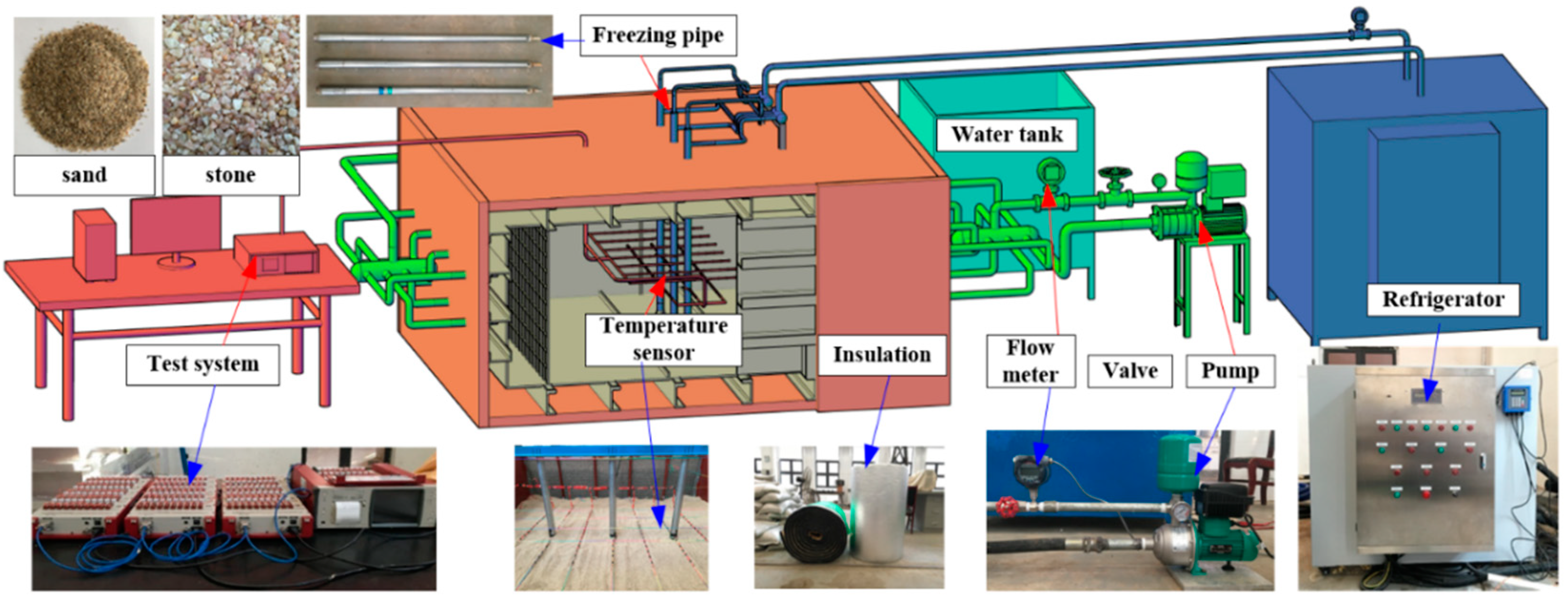
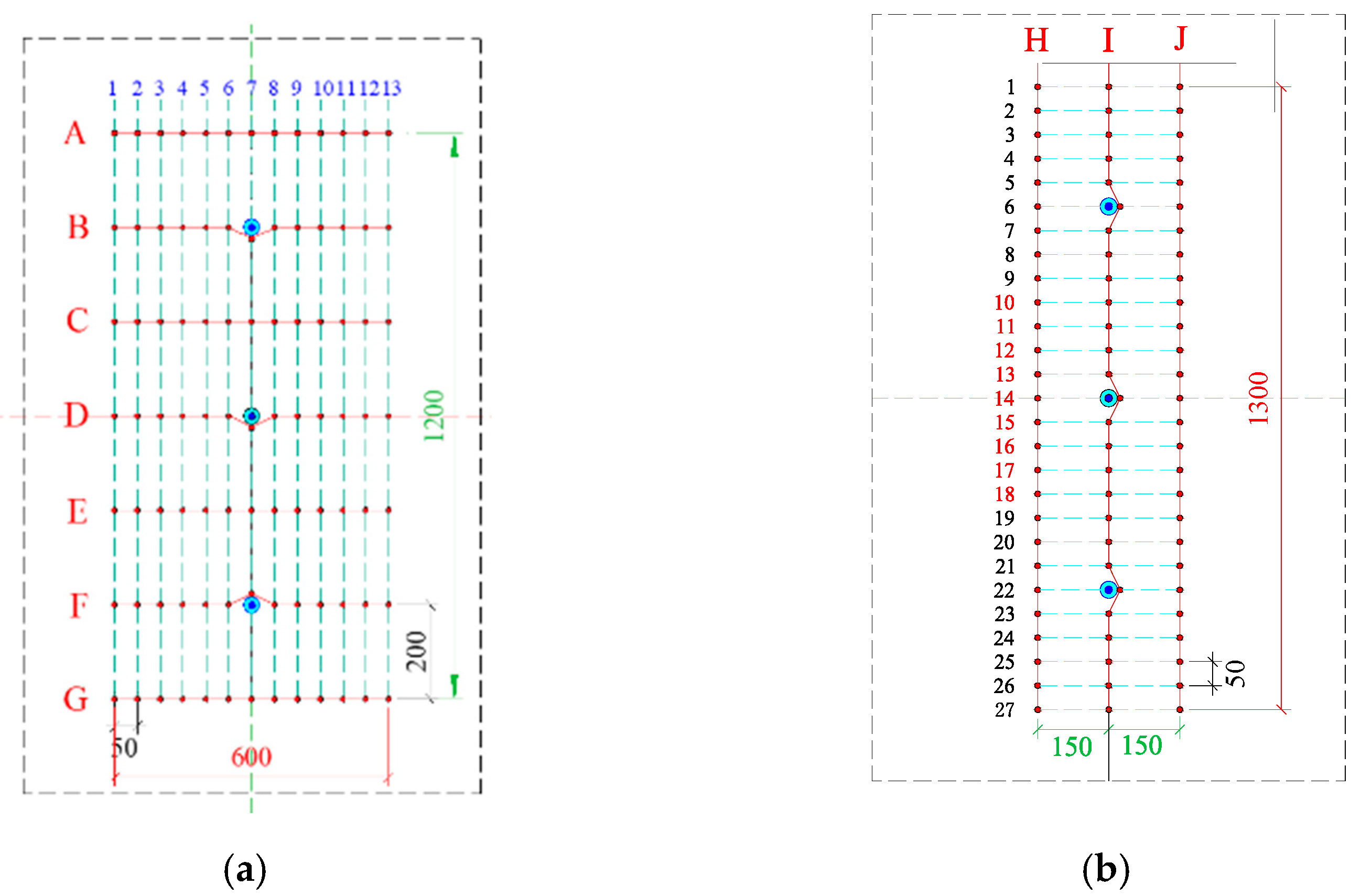
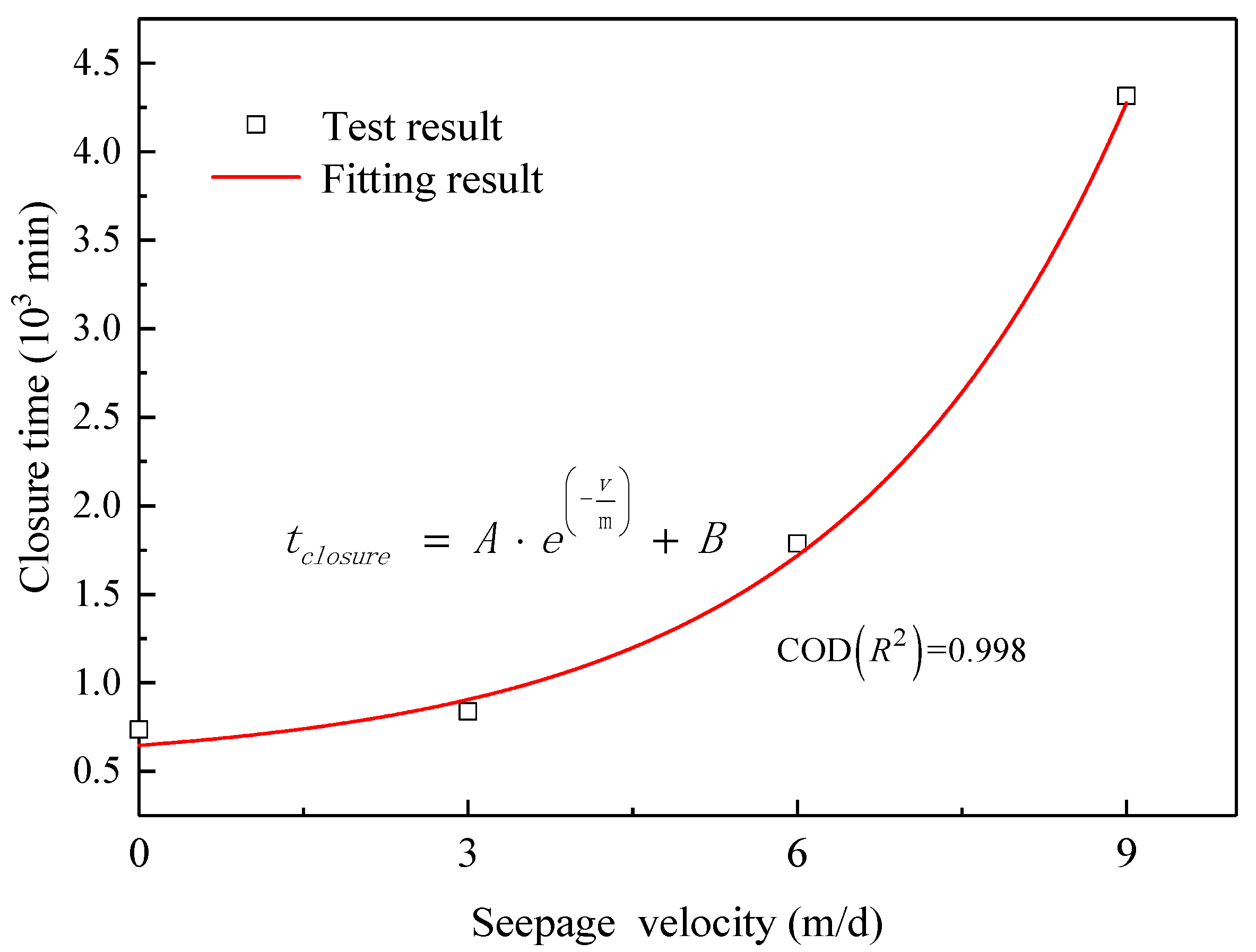
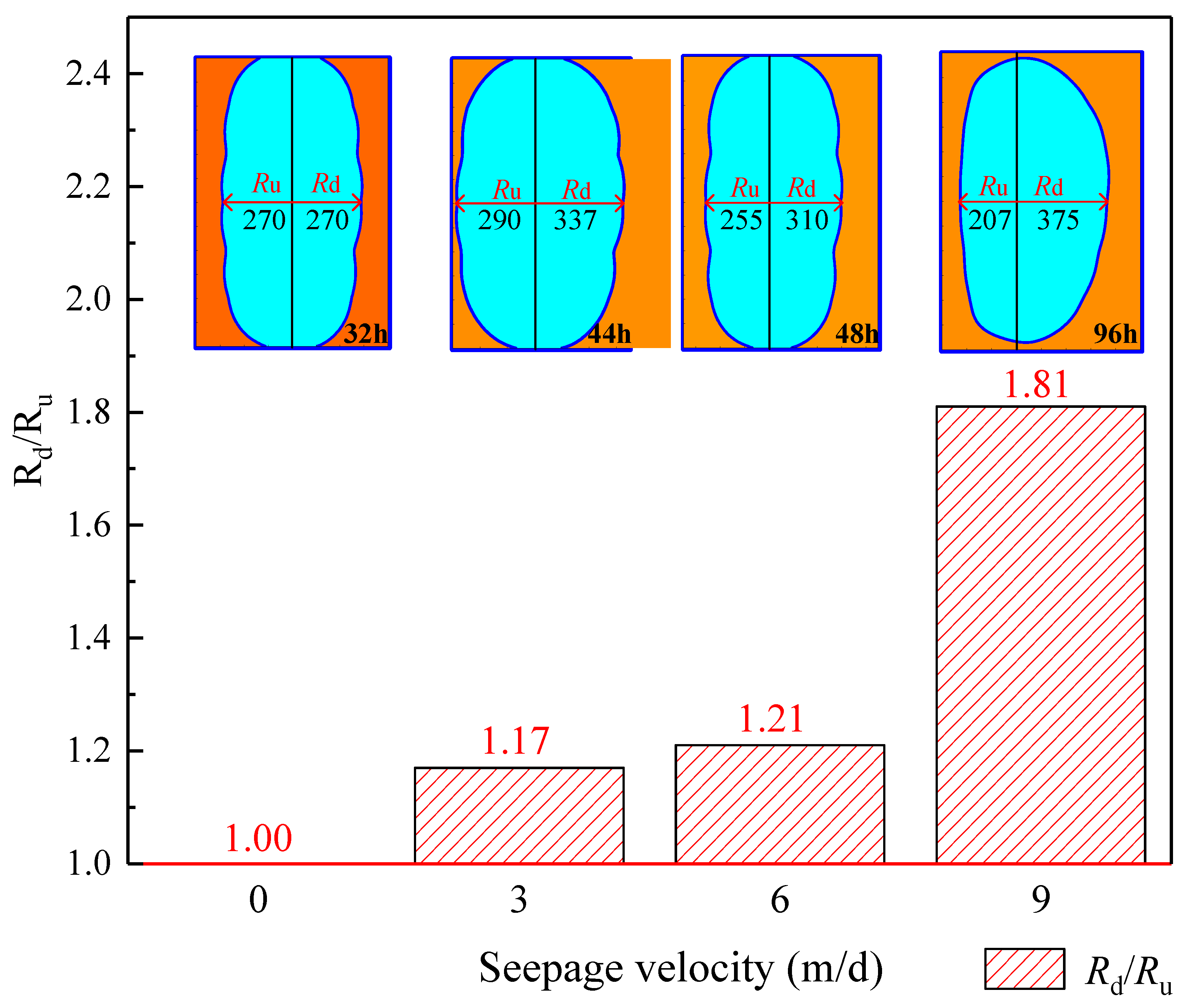
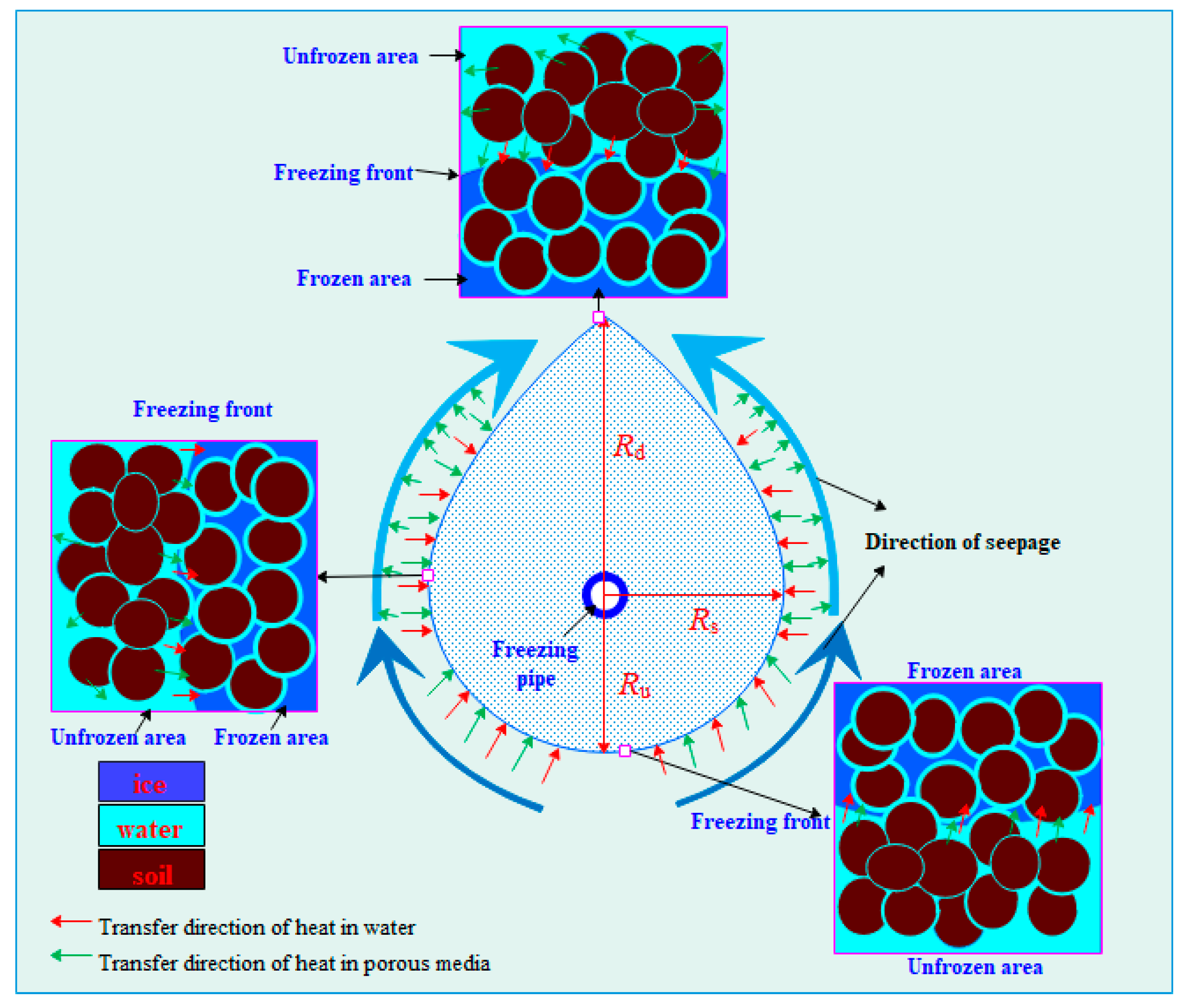
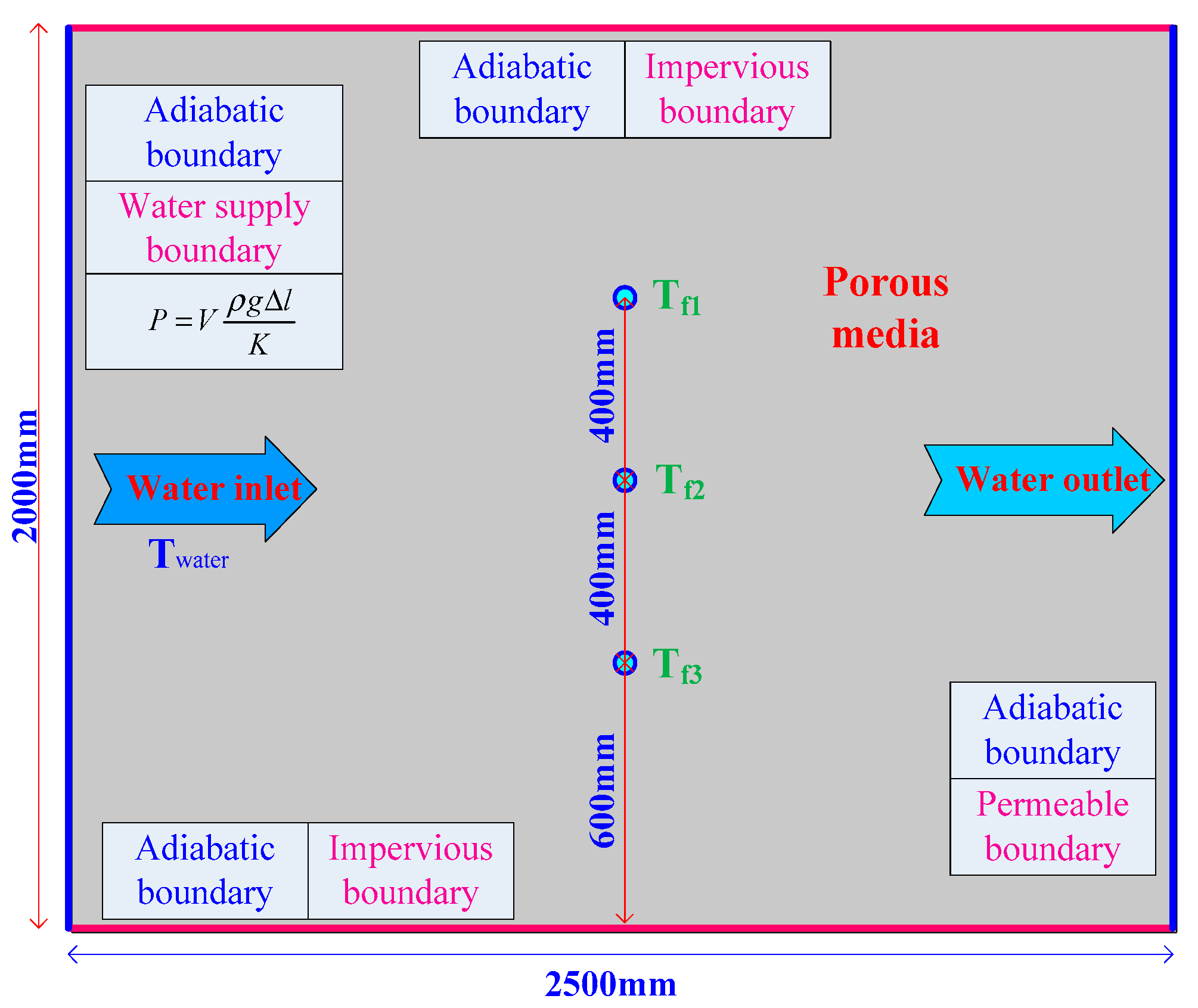
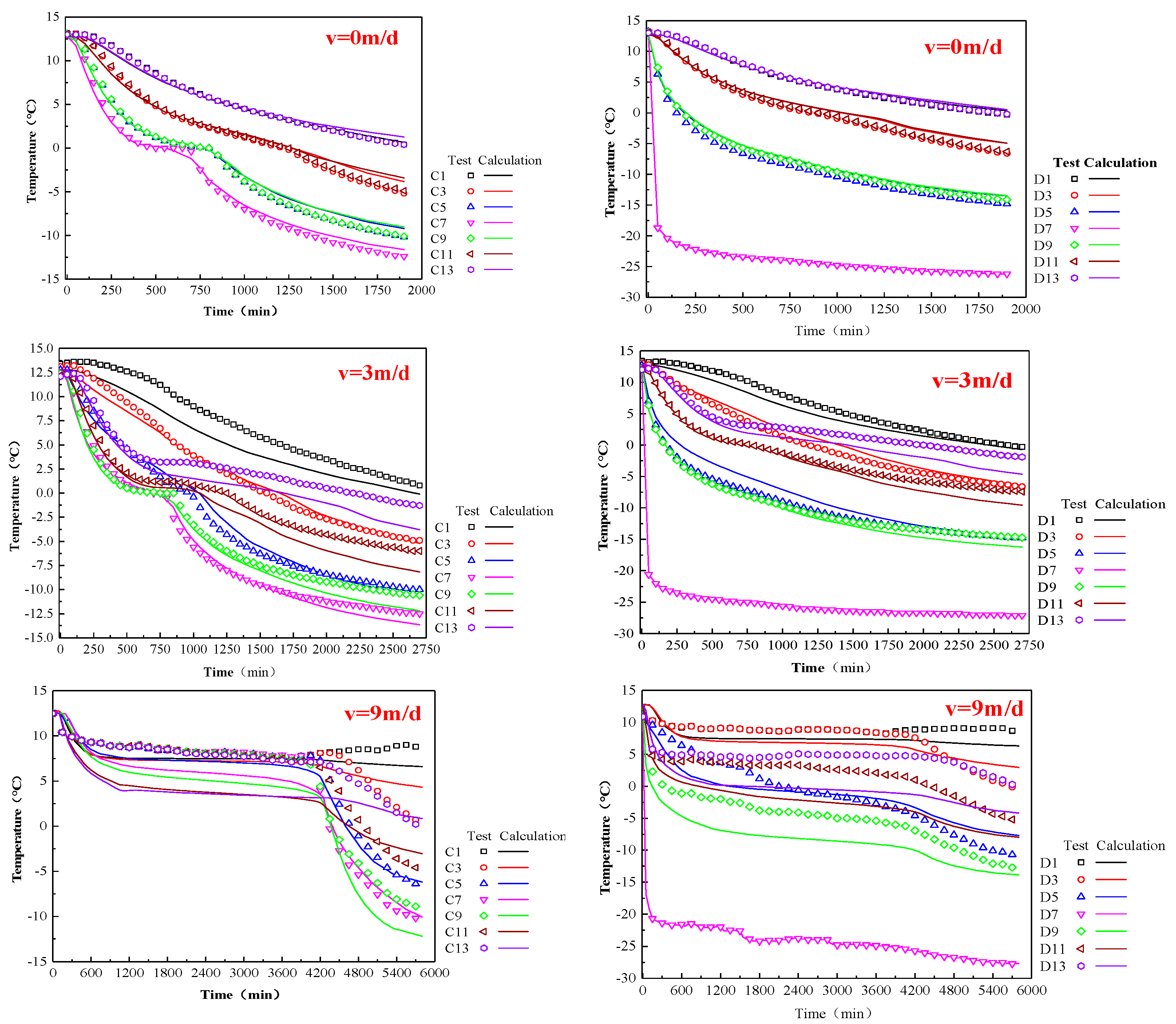
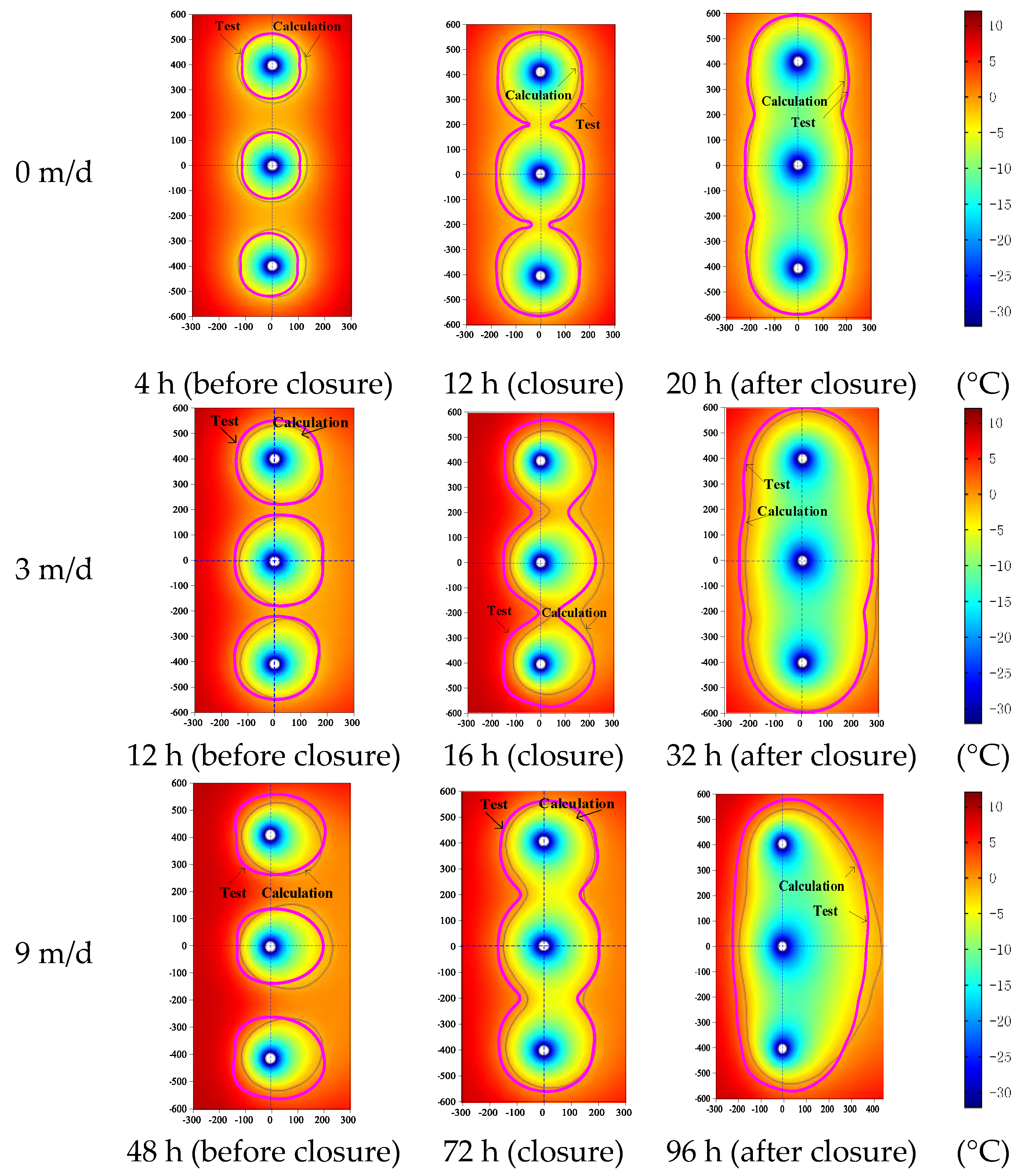

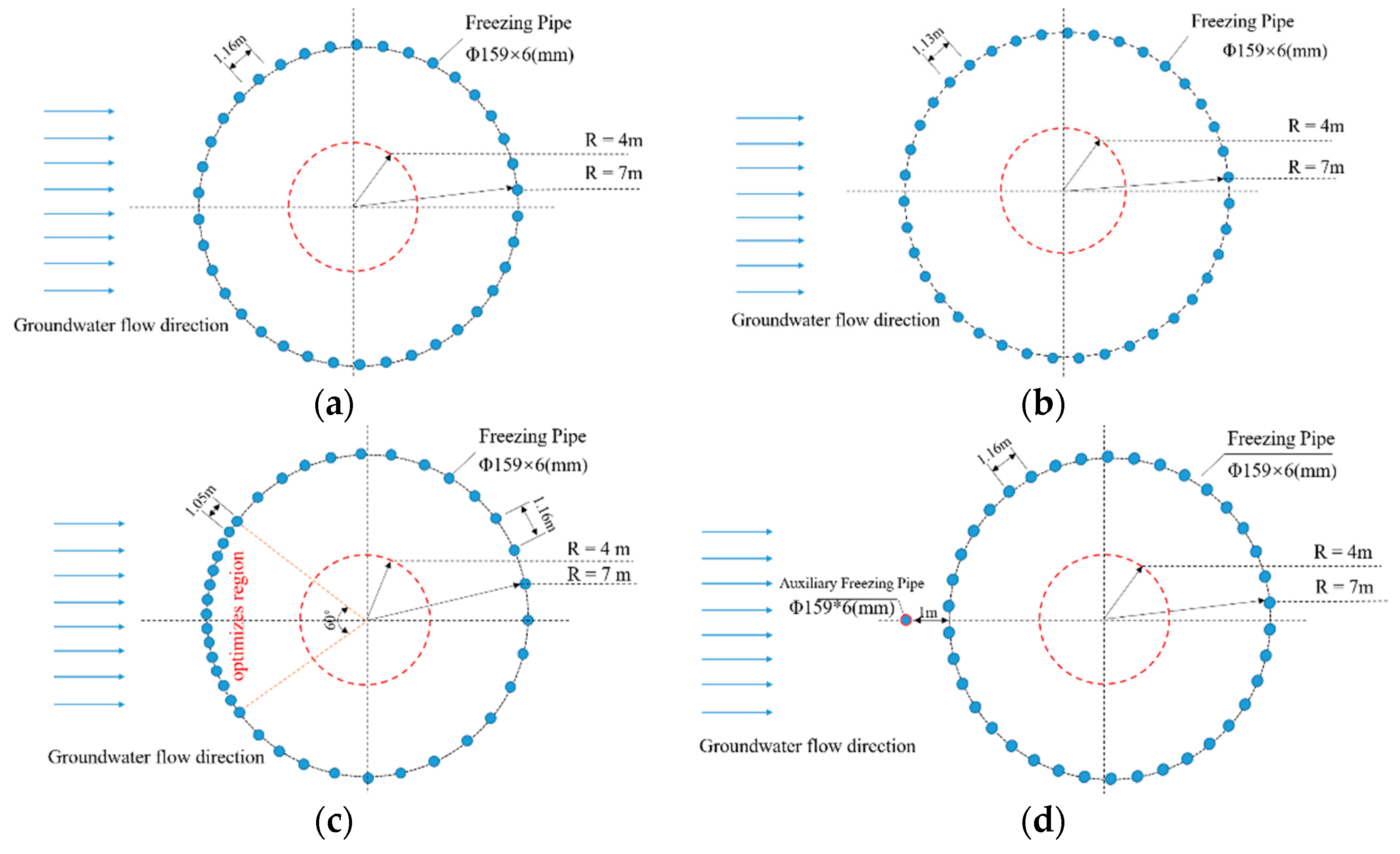
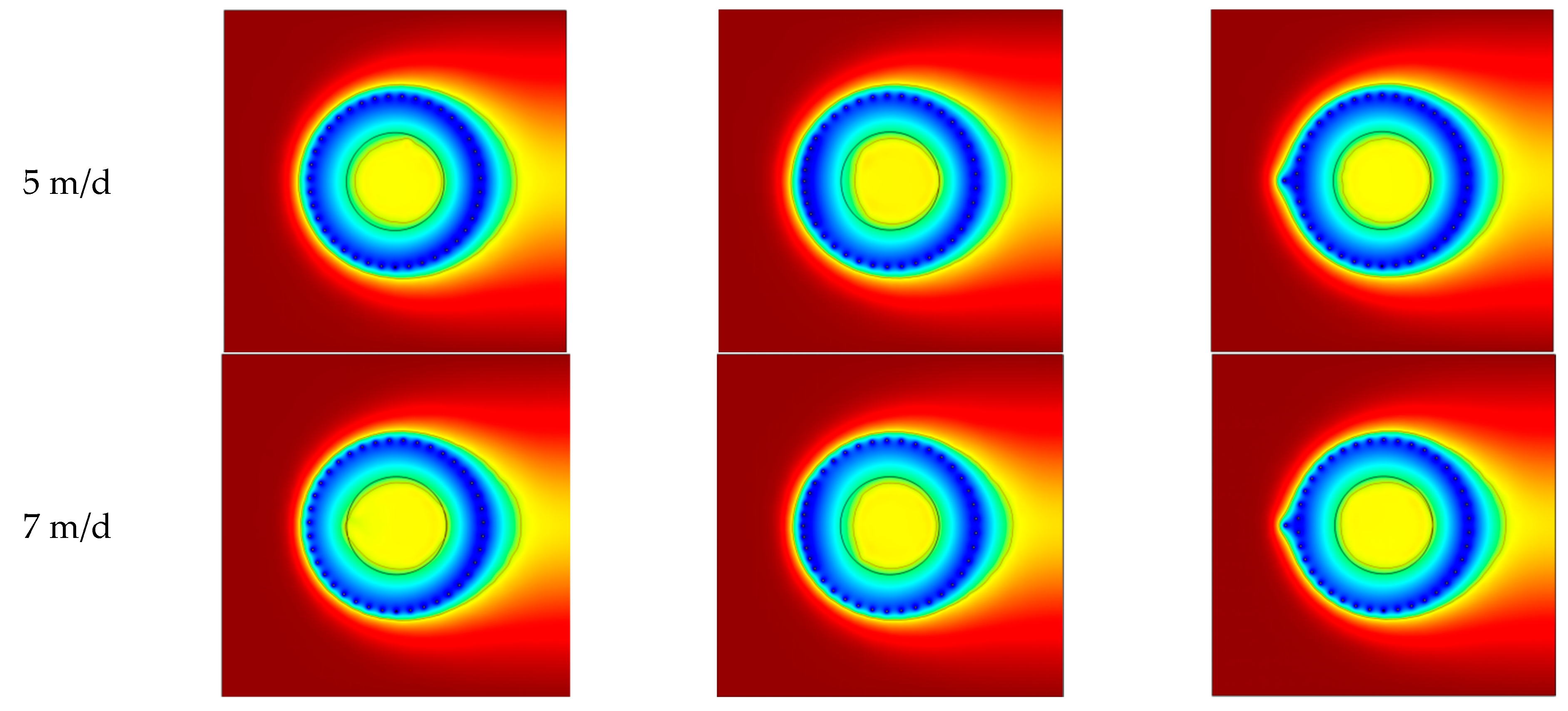
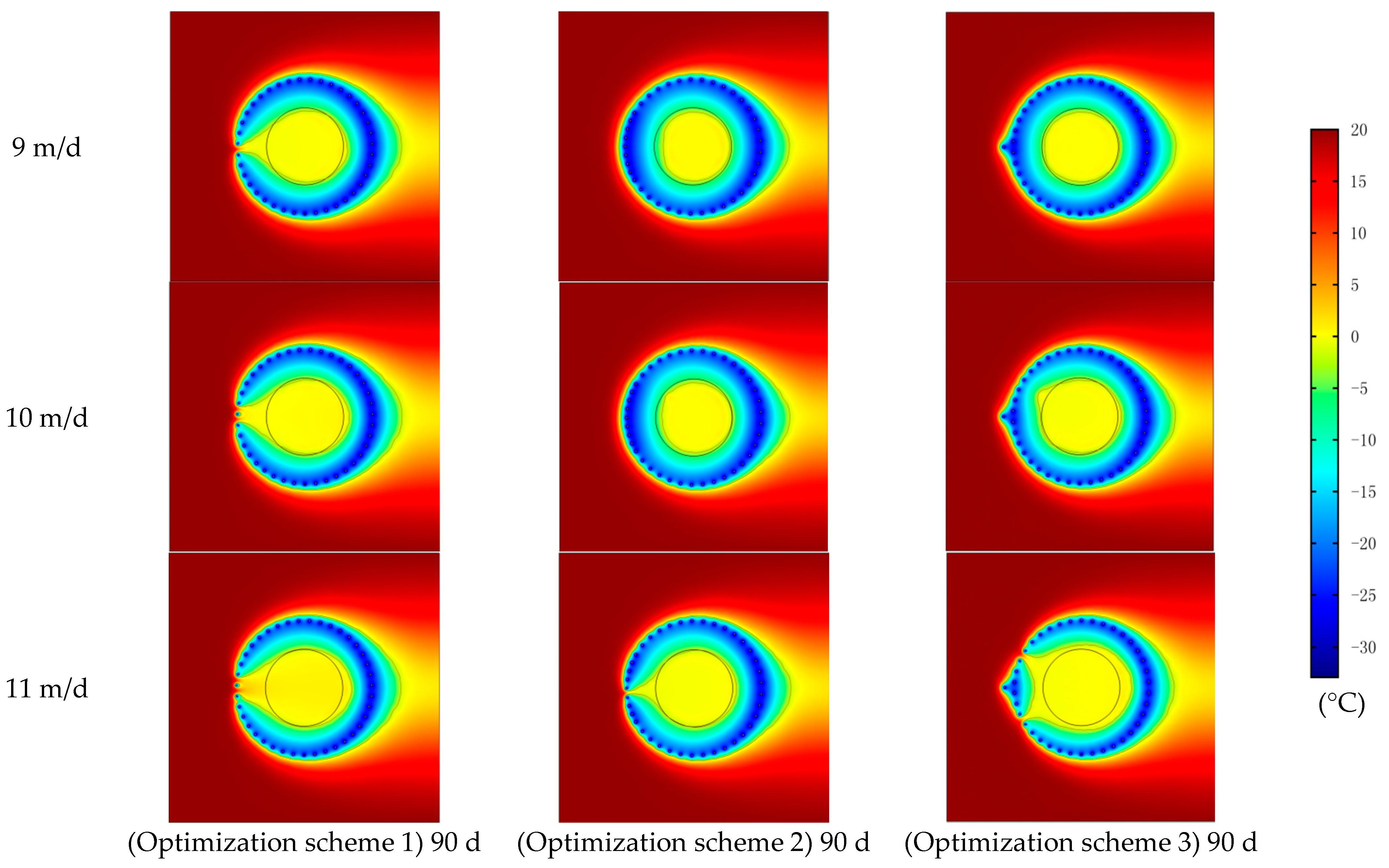

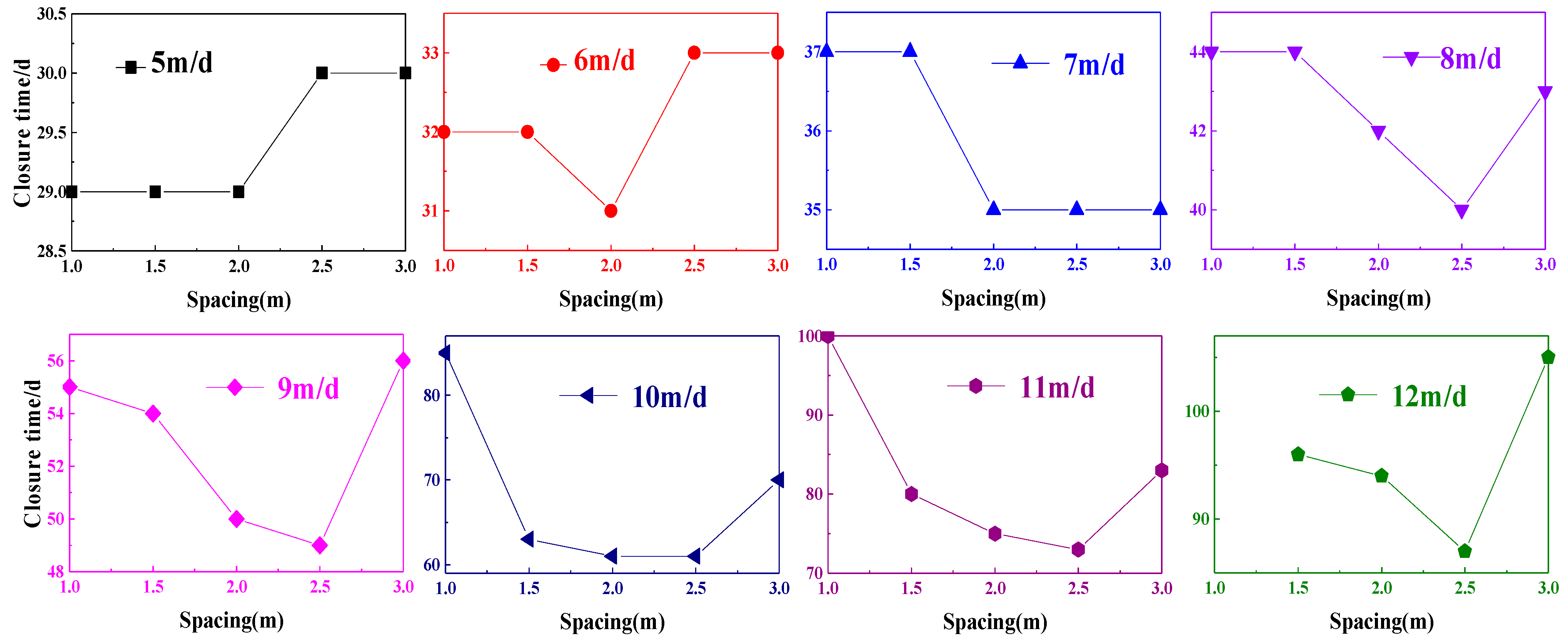
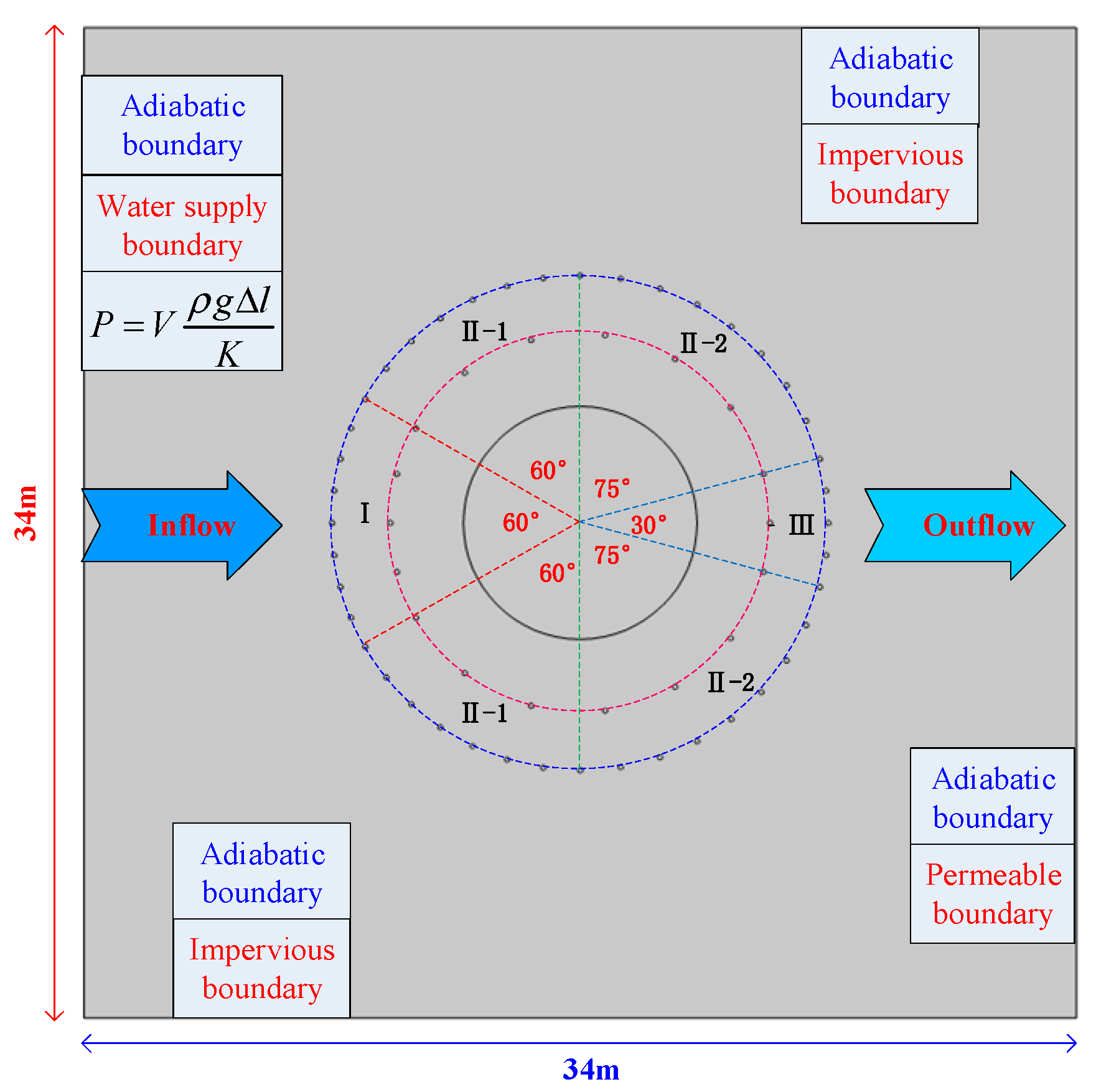
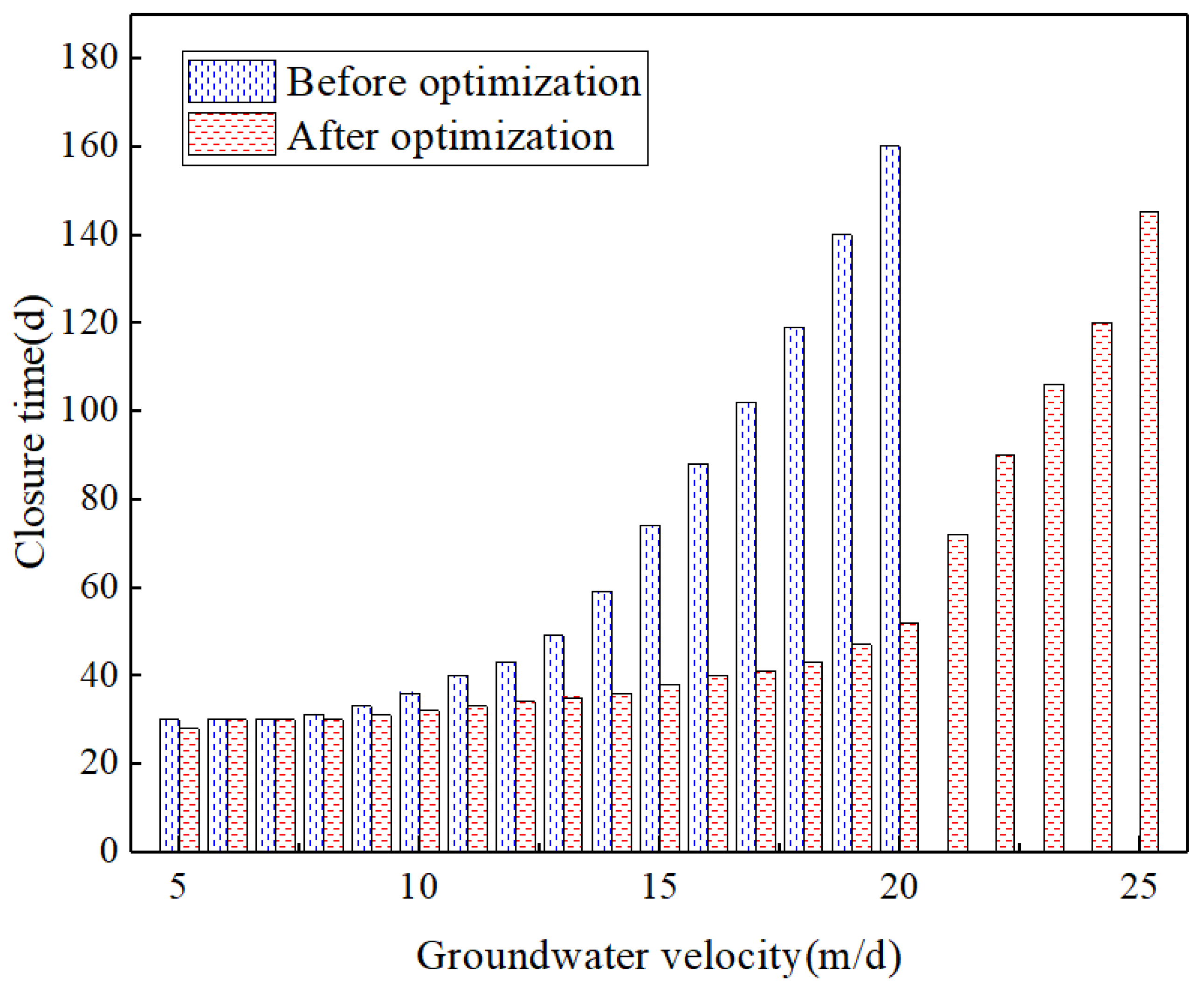
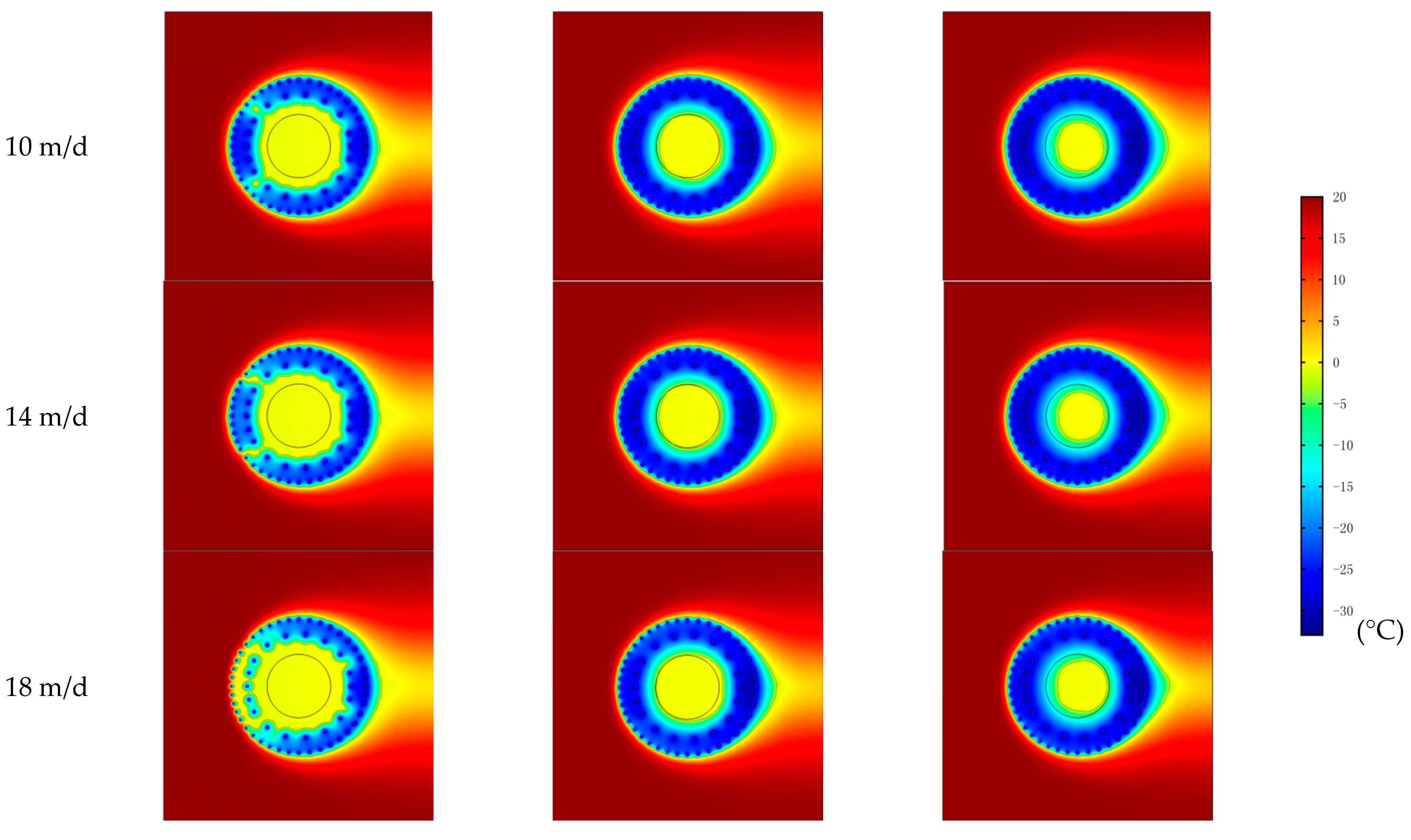
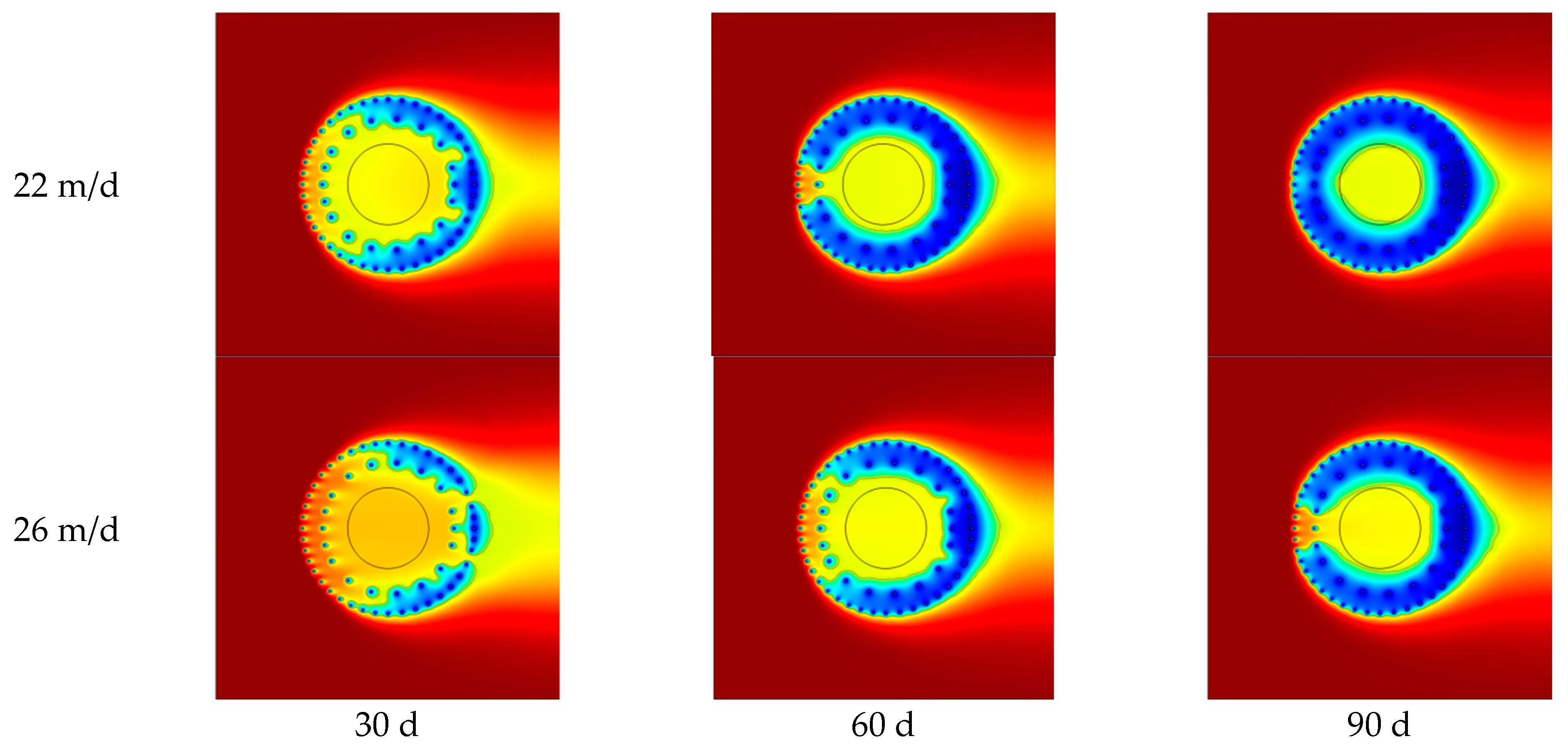
| Project | Date | Geological Conditions | Engineering Problems |
|---|---|---|---|
| Shenzhen Metro 4A Section | 2003 | The subway tunnel located at the intersection of Heping Road and Jiefang Road in Shenzhen city, where the stratum structure is loose, the groundwater flow rate reaches 15 m/d. | In the construction process of artificial ground freezing method, the temperature drop was slow, the temperature drop was only 0.1 °C every day, and sometimes the temperature even rose, which seriously affected the construction progress. |
| Tianjin Metro Line 2 South Building to Tucheng Section of the Contact Channel | 2006 | The stratum where the project was located was mainly quaternary floodplain sedimentary layer, which had a large pore ratio and rich water content. Moreover, there was transgression phenomenon in this area, and the groundwater flow rate was high. | The development rate of frozen wall in this region was relatively slow. |
| Shanghai Yangtze River Tunnel Project Middle Section Tunnel Connection Channel Project | 2007 | The geological condition of the strata was complex, the strata had strong permeability and the groundwater velocity was large. | In the freezing construction process, the temperature drop rate of freezing curtain was slow, and the temperature rose during the maintenance freezing period. |
| Contact Channel No. 10 between Wuyuanwan Station and LiuWudian Station of Mud-Water Shield Tunnel from Xiamen Island to Xiang’an | 2012 | The stratum where the connection channel was located was rich in water, had hydraulic connection with seawater, and the groundwater velocity was high. | The development rate of frozen wall was slow. |
| Libi Mine Auxiliary Shaft Freezing Project | 2019 | The shaft passed through the sandy cobblestone layer with a thickness of 4.33~13.56 m. A large amount of water was pumped from the adjacent water source well below the underground flow of the frozen auxiliary shaft, which increased the groundwater flow velocity of the strata. | In the sand and pebble layer (about 21 m deep), the temperature of 30#, 31#, 32#, and 33# freezing holes of the frozen wall was high, and there were abnormal “gaps”. |
| Nantong Urban Rail Transit Line 2 | 2020 | The formation was supersaturated silty soil, and the groundwater flow rate reached 7.5 m/d. | The frozen wall developed slowly. |
| Test | The Seepage Velocity | Water Flow | The Water Temperature |
|---|---|---|---|
| 1 | 0 | 0 | / |
| 2 | 3 m/d | 0.25 m3/h | 15 °C |
| 3 | 6 m/d | 0.50 m3/h | 15 °C |
| 4 | 9 m/d | 0.75 m3/h | 15 °C |
| Refrigerant | Density (kg/m3) | Specific Heat (J/(kg·°C)) |
|---|---|---|
| CaCl2 (28.5%) | 1270 | 2.7 × 103 |
| Alcohol | 789 | 2.4 × 103 |
| Parameter | CaCl2 (In the Engineering) | Alcohol (In the Test) |
|---|---|---|
| Flow rate | 4~10 m3/h | 2.34~5.94 m3/h |
| Temperature | −32 °C | −32 °C |
| The Seepage Velocity (m/d) | Closure Time (min) | Delayed Time (min) |
|---|---|---|
| 0 | 720 | - |
| 3 | 805 | 85 |
| 6 | 1760 | 955 |
| 9 | 4300 | 2540 |
| Parameter | Value | Unit | |
|---|---|---|---|
| The inner diameter of the wellbore | 6 | m | |
| Diameter of excavation | 8 | m | |
| Freezing hole | Diameter of layout circle | 14 | m |
| Quantity | 38 | 1 | |
| Spacing | 1.16 | m | |
| Temperature | −32 | °C | |
| Size | 159 | mm | |
| 159 × 6 | |||
| Parameter | Value | Unit | |
|---|---|---|---|
| The inner diameter of the shaft | 7 | m | |
| Diameter of excavation | 9 | m | |
| The auxiliary freezing holes | The diameter of the layout ring | 13 | m |
| Quantity | 18 | 1 | |
| Hole spacing | 2.27 | m | |
| Temperature | −32 | °C | |
| Size | 159 × 6 | mm | |
| The main freezing holes | The diameter of the layout ring | 17 | m |
| Quantity | 42 | 1 | |
| Hole spacing | 1.27 | m | |
| Temperature | −32 | °C | |
| Size | 159 × 6 | mm | |
| Row spacing | 2 | m | |
| Original Scheme | Optimization Scheme | |||||||
|---|---|---|---|---|---|---|---|---|
| Location | Quantity | Spacing/m | Location | Quantity | Angle/° | Spacing/m | ||
| Inner circle | 18 | 2.27 | Inner circle | I | 5 | 18 | 60 | 1.7 |
| II (×2) | 5 | 135 | 2.55 | |||||
| III | 3 | 30 | 1.7 | |||||
| Outer circle | 42 | 1.27 | Outer circle | I | 9 | 42 | 60 | 1.11 |
| II-1 (×2) | 7 | 60 | 1.27 | |||||
| II-2 (×2) | 7 | 75 | 1.39 | |||||
| III | 5 | 30 | 1.11 | |||||
Publisher’s Note: MDPI stays neutral with regard to jurisdictional claims in published maps and institutional affiliations. |
© 2022 by the authors. Licensee MDPI, Basel, Switzerland. This article is an open access article distributed under the terms and conditions of the Creative Commons Attribution (CC BY) license (https://creativecommons.org/licenses/by/4.0/).
Share and Cite
Wang, B.; Cao, Y.; Rong, C.; Cheng, H. Study on the Mechanism and Prevention Method of Frozen Wall Maldevelopment Induced by High-Flow-Rate Groundwater. Water 2022, 14, 2077. https://doi.org/10.3390/w14132077
Wang B, Cao Y, Rong C, Cheng H. Study on the Mechanism and Prevention Method of Frozen Wall Maldevelopment Induced by High-Flow-Rate Groundwater. Water. 2022; 14(13):2077. https://doi.org/10.3390/w14132077
Chicago/Turabian StyleWang, Bin, Yi Cao, Chuanxin Rong, and Hua Cheng. 2022. "Study on the Mechanism and Prevention Method of Frozen Wall Maldevelopment Induced by High-Flow-Rate Groundwater" Water 14, no. 13: 2077. https://doi.org/10.3390/w14132077
APA StyleWang, B., Cao, Y., Rong, C., & Cheng, H. (2022). Study on the Mechanism and Prevention Method of Frozen Wall Maldevelopment Induced by High-Flow-Rate Groundwater. Water, 14(13), 2077. https://doi.org/10.3390/w14132077







